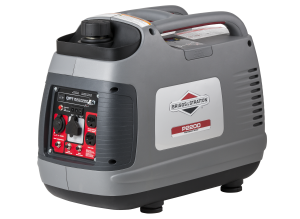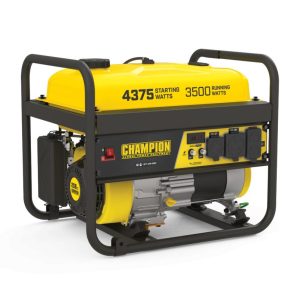12 Causes of Pulsar Generator Failure: FIXED
If the generator stops working, you will need to get it repaired as soon as possible or you will most likely be without a source of electricity. I have compiled a list of things that need to be checked in order to get your generator back up and running.
A Pulsar generator will turn on but will quickly shut off if the fuel tank is empty, the fuel filter is blocked, the carburetor is filthy, the fuel line is clogged, the gas cap is broken, the spark plug is dirty, the ignition coil is broken, the engine oil level is low, or the gas is old.
Before attempting any repairs, you should first wait for the engine to calm down and then remove the spark plug wire. In the Pulsar operator’s handbook, there are safety precautions that should be followed.

Table of Contents
Your Pulsar Generator Starts Then Dies and Shuts Off
1. The Fuel Tank of a Pulsar Generator Is Empty
Obviously, you need gas to run a gas-powered generator. You may have developed a fuel leak or the fuel gauge may have stopped working causing you to run out of fuel quicker than you thought.
SOLUTION:
It is essential that the generator be positioned on a level surface. Conduct a thorough inspection of the machinery to ensure that there is not a fuel leak and that the fuel gauge is functioning appropriately. When necessary, make the necessary repairs.
The generator has to have new fuel added to it.
2. Old Fuel in a Pulsar Generator
Leaving stale gas in a generator for an extended period of time may have a detrimental impact on both the fuel system and the engine. When gas gets old, it can develop a varnish that makes it difficult to burn fuel.
When there is less gasoline reaching the engine, the generator may splutter and may even stop working altogether.
Because gas begins to degrade and lose its effectiveness as soon as 30 days after it is purchased, it is essential to use fresh gas and consume it within this time frame.
I am aware that this is easier to say than it is to accomplish. You are only allowed to use the generator when there is a disruption in your power supply, and you are never sure when the next time you will need to use the generator will be.
Because of this, prior to putting new gas into the fuel tank, you need first add a fuel additive to the gas in the tank. By stabilizing the gasoline and lowering the amount of moisture that it contains, fuel additives like Sea Foam Motor Treatment may extend its shelf life.
If you want the greatest outcomes possible from your gasoline, follow these tips:
- Unleaded gasoline with an octane value of at least 87 and an ethanol percentage of no more than 10% is required for use in pulsar generators that have four-cycle engines. Do not use gasoline that has a greater percentage of ethanol in it. Please read this page carefully if your Pulsar is equipped with a two-cycle engine so that you can choose the appropriate kind of gasoline.
- Utilize the gas within the next 30 days.
- Never store gasoline outside or in other locations where it might get contaminated by dampness.
- Keep the gas in a dry location.
- Don’t purchase more petrol than you can use up inside the next month. If you buy more than this amount, you should stabilize your gas by adding a gasoline additive.
SOLUTION: Empty the old gas into a container so that it may be disposed of in the correct manner. To maintain the system’s stability and ensure that it is clean, you should use new gasoline that has been treated with a fuel additive.
3. Plugged Fuel Filter on a Pulsar Generator
Before the gasoline reaches the carburetor, the fuel in some portable fuel generators manufactured by Pulsar may be filtered using an inline fuel filter that is installed between the fuel lines. Its job is to prevent dirt and other particles from getting into the fuel system in whatever way they can.
It is possible for the filter to accumulate dirt, which would then prevent gasoline from passing through the filter. It’s possible that the engine won’t start up because it’s not receiving enough gasoline.
In the event that you are unable to locate a Pulsar generator with an integrated filter, you will discover that other Pulsar generators have filters that are difficult to reach. It is possible that it is a thin filter that is placed into a gasoline component or that it is situated at the bottom of the fuel tank.
SOLUTION: Clean or replace a gasoline filter that is unclean. Because switching to a different kind of filter is more difficult, you might want to have a mechanic locate and replace the filter on generators that do not have an inline fuel filter.
4. The Fuel Line on Your Pulsar Generator Has Been Blocked
A plugged fuel line is another factor that may reduce the amount of gasoline that can flow. You may locate a blockage in a fuel line by pausing and restarting the flow of gasoline while monitoring the amount of fuel that emerges from each segment of the fuel line.
SOLUTION: If there is a limitation in the line, you will need to disconnect the fuel line from the generator and then spray some carburetor cleaner into the line. This will assist loosen the clog and allow you to remove the restriction. After that, you will need to use compressed air to blast air through the pipe until the blockage is gone.
Install the cable once more. In the event that you are unable to remove the clog or discover that the gasoline line is dry and broken, it is simple to install a new fuel line in its place.
5. There’s a Problem with the Fuel Pump in Your Pulsar Generator
In the event that the carburetor is positioned higher than the gasoline tank, your Pulsar generator will make use of a fuel pump. To transfer gasoline upward, you will need to use a pump. A fuel pump is not required for all types of generators.
If the fuel pump stops working, the carburetor will not get the necessary amount of gas, and the generator will stop working.
Ensure that gasoline is being supplied to the pump’s inlet port before beginning the testing procedure for the fuel pump. After that, take the line out of the carburetor and put it in a container for safekeeping.
Start the vehicle’s engine and keep an eye out for a consistent or pulsing flow to emerge from the line.
SOLUTION: In the event that the fuel pump is unable to provide a consistent flow of gasoline to the carburetor, it should be replaced.
6. The Carburetor on Your Pulsar Generator is Covered with Gunk.
It’s possible that a buildup of varnish within the carburetor will prohibit it from letting the appropriate quantity of gas combine with the air to produce combustion in the cylinder of the engine.
When the engine is no longer capable of getting the appropriate air and fuel combination, the Pulsar generator may become slow and eventually shut down.
SOLUTION: In order to eliminate the sticky deposits and crusty buildups that have accumulated in your carburetor as a result of using old gasoline or fuel that contains ethanol, you will need to clean it. It’s possible that you’ll need to repair or replace your carburetor if it’s really dusty or if it has components that are damaged.
7. An incorrect setting for the choke on a pulsar generator
In order to start a Pulsar generator with a cold engine, the choke must be closed first. This will limit the airflow. After the engine has reached operating temperature, the choke should be moved to the open position so that there is increased airflow and the engine can continue to operate.
SOLUTION: If you start your engine and it turns over briefly before turning off again, check to see that the choke is not engaged and that it is set to the open position. If the choke setting is correct but you are still not receiving enough air to the engine, check to see if the choke is blocked or if the air filter is clogged.
.
8. The Pulsar Generator Might Have a Clogged Air Filter
It is important to have an air filter installed in order to prevent dirt from entering the air intake and wearing out the engine. This is a significant component that requires regular inspection in order to ensure that it remains in excellent shape.
I would advise the typical homeowner to clean or replace the air filter a few times each year and to replace it once per year on average. You will need to change the filter if you see that it has become excessively soiled or is broken.
If you are using the generator in dusty and dry circumstances, you will almost certainly need to change it out more often.
If you do not clean or replace the filter on a regular basis, it is possible for the filter to get clogged with so much dirt that the engine will not receive an adequate amount of air. It is possible for the engine to overheat, which would result in substantial and irreparable damage.
Performing maintenance on a foam-style air filter for a Pulsar generator
- Take out the air filter and place it somewhere safe.
- Remove any leftover dirt from the housing and cover of the air filter using a clean cloth. It is essential that the air intake not be contaminated with dirt.
- Examine the foam filter for any signs of damage, and if any is found, replace it.
- If the filter is in excellent condition, wash it in soapy water and rinse it until the water is clear. If the filter is not in good condition, replace it.
- After you have squeezed the filter, set it aside to dry.
- When it comes to different models, some call for the foam filter to be doused in oil, while others demand that it be doused in gas. Apply some pressure to the filter in order to remove any surplus fluid. If you are unclear as to the fluid you should use to coat the filter on your model, the operator’s handbook should be consulted for guidance.
- Put in place the new air filter.
- Re-attach the lid to the air filter.
To clean a paper air filter used by a Pulsar generator:
- Take out the air filter and place it somewhere safe.
- Remove any leftover dirt from the housing and cover of the air filter using a clean cloth. It is essential that the air intake not be contaminated with dirt.
- Check the paper filter that is in the air. Tap the filter to dislodge dirt, which will then fall out of the filter as a result of your tapping. Replace the filter with a new one if it has a lot of dirt on it, if it is broken, or if it no longer seals the air intake properly.
- Put in place the new air filter.
- Re-attach the lid to the air filter.
SOLUTION: If you notice that your air filter has become clogged, clean it by following the steps outlined below for the specific kind of air filter that you have. Consult the operator’s manual for the Pulsar if you are unsure of the type of filter you have or the cleaning procedure associated with it.
9. Your Pulsar Generator Might Have a Defective Gas Cap or Fuel Tank Vent
It is necessary for the gasoline tank to have a vent in order to allow air to flow through it and maintain a constant pressure within the tank.
In the event that the vent is blocked, the tank will create a vacuum that will prevent fuel from reaching the carburetor. Because of this, the generator won’t be able to operate.
Use a pressure gauge to discover any vacuum buildup in the tank so you can evaluate whether or not the gasoline tank vent is the source of the trouble you are having starting the vehicle.
If you do not have a pressure gauge, you can diagnose and fix the problem by following these easy steps:
- Turn the cap counterclockwise to let air into the container.
- Get the generator up and running.
- If it starts easily and maintains a strong speed, the problem may lie in the tank vent.
- Confirm that there is a problem by first ensuring that the fuel cap is securely fastened and then starting the generator to recreate the issue.
- If the engine turns over but does not continue running or starts running slowly until the fuel cap is loosened, the fuel tank vent is probably clogged and has to be replaced.
SOLUTION: If you discover that the gasoline tank is no longer venting correctly, you will need to replace either the gas cap or the rollover valve tank vent that is situated on the top of the fuel tank (depending on the type of Pulsar you have).
10. The Spark Plug on Your Pulsar Generator is Covered with Gunk
The spark plug was responsible for producing the spark that was necessary to get it started; however, if the plug is very filthy or broken, it is possible that it may have intermittent spark difficulties, which will cause the generator to splutter and eventually stop working.
SOLUTION: Take out the spark plug and inspect it to see what kind of condition it’s in. You need to replace the spark plug with a new one if the tip has a very dark color, the electrode is worn, or the porcelain is shattered.
If it seems to be in excellent condition, clean it with a wire brush, check the electrode gap, and connect the spark plug wire in a secure manner. If not, repeat the process. It’s also possible for the generator to stop working if a wire is chaffed or the spacing on the spark plug is off.
11. The Pulsar Generator You Use Has a Defective Ignition Coil
Make sure that your spark plug is in excellent shape first before moving on to inspecting the ignition coil to see whether it is broken. The spark plug is able to start the engine thanks to the ignition coil, which delivers electricity to it.
The engine will not start if the spark plug is unable to ignite owing to a malfunction in either the ignition coil or the spark plug itself.
SOLUTION: Employing an ohm meter, check that the ignition coil maintains its continuity. Changing out the ignition coil is necessary if you discover a break in the circuit’s continuity.
12. The Pulsar Generator does not have an adequate amount of engine oil.
It’s possible that your generator may operate for a time and then cease working all of a sudden. Check to check whether the warning light for low engine oil is on.
Pulsar is equipped with a sensor that will turn it off in order to prevent any harm to the engine in the event that the oil level drops too low. It will not start again until the problem with the engine oil level is fixed.
It’s possible that the fact that it won’t keep operating will be quite aggravating. Nevertheless, the fact that the generator has turned off is a positive development.
If you continue to run an engine that is almost out of oil, you might end up causing substantial damage to the engine. This is because the absence of enough lubrication will produce increased friction and heat inside the engine. It is possible for the engine to become so hot that the components will start to melt.
SOLUTION: To begin checking the amount of engine oil, position the generator so that it is flat and level on a surface. In order to remove the oil, first remove the oil fill cap and then use a clean cloth to wipe up the dipstick.
Place the dipstick back into the oil-fill tube, but do not screw the cover back onto the tube. Take it off, and then examine the oil level shown on the dipstick. Check to see if it is within the acceptable range on the dipstick.
In the event that it is not, adjust the level of the engine oil by either draining or adding a little amount of oil until it reaches the appropriate level.
If you check the engine oil level and discover that it is at the right level, but the low oil sensor continues to light up, you may have a malfunctioning sensor. It is in everyone’s best interest to get the generator fixed at an authorized service location.







